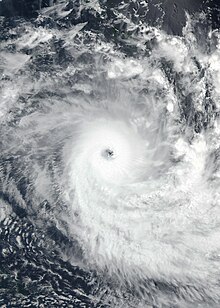 Cyclone Jasper at peak intensity on 8 December | |
| Meteorological history | |
|---|---|
| Formed | 2 December 2023 |
| Dissipated | 18 December 2023 |
| Category 5 severe tropical cyclone | |
| 10-minute sustained (BOM) | |
| Highest winds | 215 km/h (130 mph) |
| Lowest pressure | 926 hPa (mbar); 27.34 inHg |
| Category 4-equivalent tropical cyclone | |
| 1-minute sustained (SSHWS/JTWC) | |
| Highest winds | 220 km/h (140 mph) |
| Lowest pressure | 937 hPa (mbar); 27.67 inHg |
| Overall effects | |
| Fatalities | 1 total |
| Missing | 1 total |
| Damage | $675 million (2023 USD)[1] |
| Areas affected | Solomon Islands, Far North Queensland |
Part of the 2023–24 South Pacific and Australian region seasons | |
Severe Tropical Cyclone Jasper was the wettest tropical cyclone in Australian history, surpassing Cyclone Peter of 1979.[2] The third disturbance of the 2023–24 South Pacific cyclone season and the first named storm and severe tropical cyclone of the 2023–24 Australian region cyclone season, Jasper was first noted as an area of low pressure located in the South Pacific Ocean, which was initially slow to develop as it tracked southwestwards through the South Pacific Ocean in Fiji's area of responsibility. The system began to consolidate as it moved towards the Australian region, with the Australian Bureau of Meteorology (BoM) upgrading the system to a Category 1 tropical cyclone on the Australian scale and naming it Jasper. The storm quickly intensified and became a Category 5 tropical cyclone on 7 December; the Joint Typhoon Warning Center (JTWC) estimated sustained winds of 220 km/h (140 mph). Jasper soon entered an environment of increasing wind shear, causing the system to steadily weaken. Its low-level circulation centre became totally exposed and it maintained a poorly defined convective structure as it approached northern Queensland. Jasper later reintensified, and on 13 December, made landfall as a Category 2 tropical cyclone off the eastern coast of the Cape York Peninsula near Wujal Wujal. Jasper then weakened into a ex-tropical low and remained traceable overland as it moved southeast, and was last noted on 18 December.
Throughout Jasper's existence, moderate to locally intense rainfall accompanied the system; the storm dropped very heavy rainfall, peaking at 2,252 mm (88.7 in) at Bairds near the Daintree River. Many locals used personal watercraft to extract people who were trapped on their roofs within the coastal suburbs. Some flights were canceled at the Cairns Airport. One man died and another went missing due to flooding caused by Jasper. Insurance Council of Australia estimate that Jasper was responsible at AU$1 billion (US$675 million).
- ^ Nicholson, Dylan (31 December 2023). "Cyclone Jasper damage bill estimated to hit $1 billion". The Cairns Post. Archived from the original on 15 February 2024. Retrieved 2 January 2024.
- ^ "Tropical Cyclone Jasper: December 2023". JBA Risk Management. Archived from the original on 25 January 2024. Retrieved 25 January 2024.